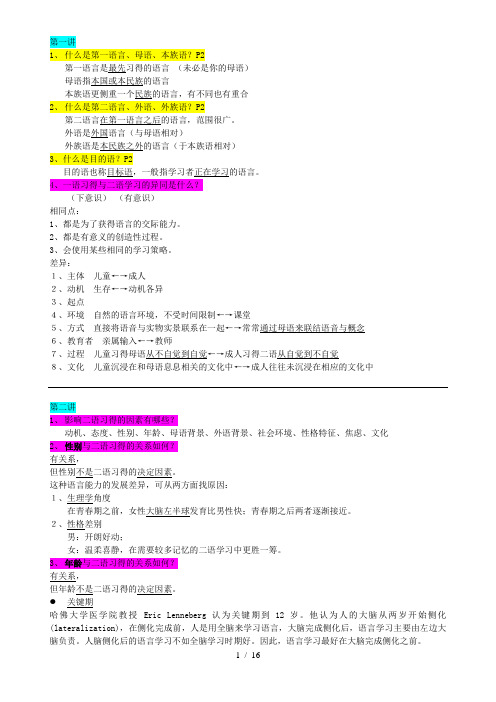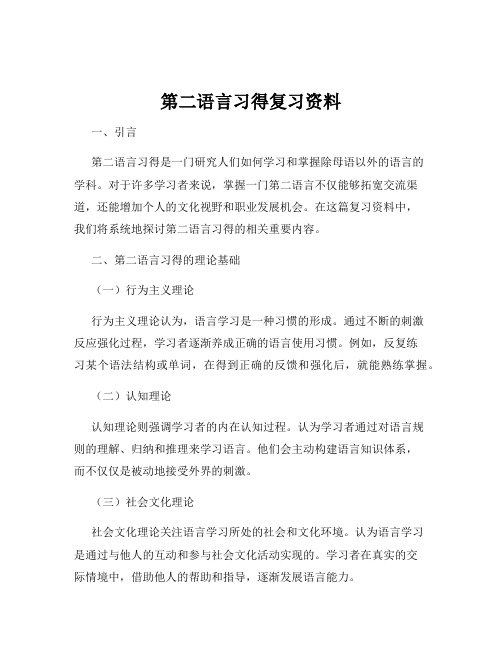最新二语习得复习提纲
《第二语言习得研究》重点知识点

《第二语言习得研究》重点知识点一、第二语言习得理论1.第二语言习得与第一语言习得的区别:第二语言习得是指学习者在已经掌握第一语言的基础上学习第二语言,与第一语言习得有所不同。
2.共同的习得条件:第二语言习得与第一语言习得都受到认知、社会、情感等多种因素的影响。
3.输入假设:学习者习得第二语言的过程中需要大量的输入来构建语言知识和语言能力。
二、第二语言习得过程1.初始期:学习者对第二语言的习得处于初始阶段,主要表现为对语言规则的不熟悉,需要借助外语教学材料和教师的指导。
2.中期:学习者开始积累语言知识,并能够进行简单的口语表达和书面表达,但仍然存在语法错误和用词不准确等问题。
3.发展期:学习者的语言技能和语言运用能力在这个阶段得到显著提高,能够流利地进行口语交流和书面表达。
4.准母语期:学习者的第二语言已经达到与母语相近的程度,几乎能够毫无困难地实现听、说、读、写等各方面的能力。
三、第二语言习得影响因素1.基础能力:个体的智力、工作记忆、认知能力等对第二语言习得有重要影响。
2.学习策略:学习者在习得第二语言过程中采取的方法和策略也对习得效果产生影响。
3.情感因素:学习者对学习第二语言的情感态度、自信心等情感因素对习得过程产生影响。
4.环境因素:学习者所处的学习环境,包括学校、家庭、社会环境等对第二语言习得有影响。
四、第二语言习得教学策略1.输出与输入平衡:教师应当提供足够的输入,同时鼓励学习者进行口语和书面的输出。
2.合作学习:通过合作学习,学习者能够在与他人进行互动中提高第二语言的流利度和准确度。
3.语境创设:教师可以通过创设各种真实的语言交际情境来提高学习者的第二语言习得效果。
4.个性化教学:教师应根据学习者的个体差异,采取不同的教学策略和方法,满足每个学习者的学习需求。
以上是《第二语言习得研究》的重点知识点。
了解这些知识点能够帮助我们更好地理解学习者在学习第二语言过程中的习得情况,并且在实际的第二语言教学中有所借鉴。
第二语言习得复习整理

一、名词解释1、母语:“母语”通常是指学习者家庭或者所属种族、社团使用的语言,因而也称作“本族语”。
一般情况下,母语通常是幼儿出生后最先接触、习得的语言。
也被称作“第一语言”。
2、目标语:“目标语”,也称“目的语”,指学习者正在学习的语言。
这种语言可能是他的第二语言、第三语言甚或第四语言。
它强调的是学习者正在学习的任何一种语言,与学习者的语言习得环境无关。
美国学生无论在美国学习汉语,还是在中国学习汉语,其目的语都是汉语。
如果他们同时在学习法语,那么法语也是他们的目的语。
对第二语言学习者而言,母语对其目的语的习得具有重要的影响。
3、第二语言:相对于第一语言而言,指在母语之后再学习另一种语言。
第二语言习得可能发生在自然环境,也可能在正规的课堂环境中。
在课堂环境下学习的第二语言被称为外语。
Ellis (1994)“第二语言”是相对于学习者习得的第一语言之外的任何一种其他语言而言的。
因此,“第二语言”自然包含第三、第四或更多的其他语言。
4、对比分析:对比分析是把两种语言进行对比,从而确定其中的相同点和不同点。
对比分析的最终目的是为了预测母语对第二语言学习可能会造成的影响,即第二语言学习者受母语干扰可能会出现的错误,从而确定教学的重点和难点,采取相应的预防性措施。
5、第二语言习得:人们在自然的语言环境中或者课堂环境中潜意识地或者有意识地获得母语之外的另一种语言。
6、中介语:“中介语”(interlanguage)这一概念是由语言学家塞林克(L.Selinker)于1969年提出来的。
中介语是指在第二语言习得过程中,学习者通过一定的学习策略,在目的语输入的基础上所形成的一种既不同于其第一语言也不同于目的语、随着学习的进展向目的语逐渐过渡的动态的语言系统。
7、偏误:偏误是对正确语言的偏离,也就是离开了轨道。
这种错误是系统的,有规律的,它反映说话者的语言能力。
8、偏误分析:系统分析学习者偏误,研究来源,揭示学习者中介语体系。
第二语言习得研究复习资料

第一章第二语言习得研究概述埃利斯(1994)明确地将第二语言习得与外语习得的概念区分开来。
“第二语言习得”是指学习者在目的语国家学习目的语。
学习者所学的目的语在目的语国家是公认的交际工具,当然也是学习者用来交际的工具。
“外语习得”是指学习者在本国学习目的语。
学习者的目的语在本国不是作为整个社团的交际工具。
这种语言学习基本上是在课堂上进行的。
“语言能力”是由交际双方内在语法规则的心理表征构成的。
简单地说,语言能力是一种反映交际双方语言知识的心理语法。
这种语法是一种隐性的语言知识。
语言能力包括:1)能指出哪些声音或语素的组合是母语中可能存在的,哪些可能是不存在的。
2)能区别符合语法的句子和不符合语法的句子。
3)能区别出一些结构相同或相似,但实际意义却不同的句子。
4)能辨别出结构不同但意义有联系的句子。
5)能辨别出句子的歧义,即同一结构具有一个以上的释义。
6)能意识到句子之间的释义关系,即结构不同的句子具有相同的语义。
“语言表达”指的是交际双方在语言的理解与生成过程中对其内在语法的表现。
关于语言运用的知识。
理想的母语者根据“递归规则”生成无限递归的句子。
第二节二语习得研究的发展一、发展阶段(一)20世纪50-60年代:理论初创阶段(二)20世纪70年代:理论大发展阶段1.偏误分析2.中介语理论假设3.习得顺序研究4.监控模式5.文化适应模式(三)20世纪80年代中期:成熟阶段1.语言学视角2.社会语言学视角3.认知视角4.社会文化视角二、理论成熟的标志1. 调查研究的领域和涉及的领域扩大2. 由理论假设发展为理论模式3. 研究方法日益科学化三、汉语作为第二语言的习得研究的发展(一)80年代,汉语习得研究起步。
1984鲁键骥“中介语理论与外国人学习汉语的语音偏误分析”1985年,第一界国际汉语教学讨论会1987年,吕必松“加强对外汉语教学的理论研究”评价:取得了一定成果,但缺乏系统研究、分析方法不够严谨、疏于解释和评价。
二语习得期末复习大纲

第一讲1、什么是第一语言、母语、本族语?P2第一语言是最先习得的语言(未必是你的母语)母语指本国或本民族的语言第二语言在第一语言之后的语言,范围很广。
外语是外国语言(与母语相对)(下意识)(有意识)相同点:1、都是为了获得语言的交际能力。
2、都是有意义的创造性过程。
3、会使用某些相同的学习策略。
差异:1、主体儿童←→成人2、动机生存←→动机各异3、起点4、环境自然的语言环境,不受时间限制←→课堂5、方式直接将语音与实物实景联系在一起←→常常通过母语来联结语音与概念6、教育者亲属输入←→教师7、过程儿童习得母语从不自觉到自觉←→成人习得二语从自觉到不自觉8、文化儿童沉浸在和母语息息相关的文化中←→成人往往未沉浸在相应的文化中第二讲1、影响二语习得的因素有哪些?动机、态度、性别、年龄、母语背景、外语背景、社会环境、性格特征、焦虑、文化2、性别与二语习得的关系如何?有关系,但性别不是二语习得的决定因素。
这种语言能力的发展差异,可从两方面找原因:1、生理学角度在青春期之前,女性大脑左半球发育比男性快;青春期之后两者逐渐接近。
2、性格差别男:开朗好动;女:温柔喜静,在需要较多记忆的二语学习中更胜一筹。
3、年龄与二语习得的关系如何?有关系,但年龄不是二语习得的决定因素。
关键期哈佛大学医学院教授Eric Lenneberg 认为关键期到12岁。
他认为人的大脑从两岁开始侧化(lateralization),在侧化完成前,人是用全脑来学习语言,大脑完成侧化后,语言学习主要由左边大脑负责。
人脑侧化后的语言学习不如全脑学习时期好。
因此,语言学习最好在大脑完成侧化之前。
●年龄和习得速度许多研究结果显示,在习得速度上,儿童并不一定占有优势。
成人在学习二语的速度上比儿童快,特别是语法。
但儿童经过足够的环境浸泡后可以超越,这种情况发生在课堂教学中的可能性不及自然环境中大。
●年龄和习得顺序实验证明,年龄不会改变习得顺序。
4、什么是语言学习的关键期?语言学习的关键期是指人的一生中有一个固定的时期比其他任何时期都更容易习得语言,过了这段时期以后,一般很难习得完美的母语。
二语习得教案考试重点

二语习得教案考试重点一、二语习得理论基础1.1 定义及重要性解释第二语言习得的概念强调二语习得在语言教学中的重要性1.2 主要二语习得理论介绍行为主义理论、认知主义理论、交际语言教学理论等分析各理论的核心观点及应用二、影响二语习得的因素2.1 个人因素介绍年龄、性别、认知风格、动机、态度等对二语习得的影响分析各因素在二语习得中的具体作用2.2 社会文化因素介绍社会、文化、教育环境等对二语习得的影响分析各因素在二语习得中的具体作用三、二语习得的过程与阶段3.1 习得与学习解释习得与学习的区别分析习得过程中的关键环节3.2 发展阶段介绍沉默期、语法干扰期、调整期、成熟期等阶段分析各阶段的特点及教学策略四、二语习得教学策略与应用4.1 教学方法与技巧介绍直接法、听说法、交际法等教学方法分析各种方法在二语习得中的应用及效果4.2 教学设计强调以学习者为中心的教学设计原则分析如何根据学习者的需求、兴趣、水平等因素设计教学活动五、评估与测试5.1 评估方式介绍口试、笔试、课堂观察等评估方式分析各种评估方式的优缺点及适用场景5.2 测试设计与分析介绍如何设计有效的二语习得测试分析测试结果,为教学提供反馈和建议六、语言输入与输出在二语习得中的作用6.1 语言输入解释语言输入的概念及重要性探讨如何提供足够的、适合学生水平的语言输入6.2 语言输出解释语言输出的概念及重要性探讨如何通过语言输出促进学生的语言习得七、语言迁移与二语习得7.1 语言迁移概述解释语言迁移的概念及类型(正迁移、负迁移)探讨语言迁移对二语习得的影响7.2 减少语言迁移的策略分析如何通过教学策略帮助学生减少语言迁移介绍避免错误、利用已有知识等策略八、语言习得中的错误分析8.1 错误分类介绍错误分类及常见错误类型分析各种错误产生的原因及特点8.2 错误处理策略探讨如何正确处理学生在二语习得过程中的错误介绍宽容对待、纠正与反馈等策略九、二语习得与外语教学9.1 课程设置与教材选择分析如何根据二语习得理论设置课程及选择教材强调课程内容、教学目标与学习者需求的一致性9.2 教师角色与专业发展探讨教师在二语习得过程中的角色分析教师如何通过专业发展提高教学质量十、二语习得研究及其启示10.1 研究方法与成果介绍二语习得研究的主要方法与成果分析各种研究对教学实践的启示10.2 发展趋势与展望分析二语习得领域的发展趋势展望未来二语习得研究对教学实践的指导作用十一、学习策略与二语习得11.1 学习策略的概念与分类解释学习策略的概念及分类,如认知策略、调控策略、交际策略等。
第二语言习得复习提纲

第二语言习得复习提纲第一章1、第一语言和第二语言的概念P 1第一语言:指人出生以后首先接触并获得的语言。
称“一语”,也叫“母语。
”第二语言:指人们在获得第一语言以后再学习和使用的另一种语言。
2、了解两种环境:课堂环境、自然环境P2第二语言可以在不同的环境中获得。
以汉语为例,如果一个人是在课堂上学习,他的环境就是“课堂环境”,也称“正式环境”;如果他不参加正式的课堂学习,而是在工作或生活中,在与中国人的交往中学习汉语,他的环境就是“自然环境”。
3什么是对外汉语教学,怎么理解“外”字P8对外汉语教学时对非母语者进行的汉语教学,是第二语言教学的一种。
“外”不是指国籍,而是语言4(名词解释)什么是母语者?什么是非母语者?P13把某种语言作为第一语言来使用的是“母语者”,把这一语言作为第二语言或者外语来使用的人是“非母语者”5理解乔姆斯基的普遍语法,理解直接消极证据、间接消极证据?儿童习得母语的特点P33. 消极证据:a直接消极证据:从他人纠错中获得的信息b间接消极证据:某一语言当中从来不出现某种形式积极证据:从环境中听到的话语儿童习得母语的特点:条件不利、结果完美、速度惊人、潜能相同、过程相同6 为什么儿童运用到积极证据?P36儿童的母语习得,是在外界刺激的激发下实现原有生物潜能的过程。
儿童所需的,仅仅是能够听到这种语言而已。
儿童在习得语言时,只能把希望寄托在积极证据上。
7 年龄和关键期,哪个最先提出来?列尼博格提出的语言习得关键期P49⏹从生物学的角度来研究语言☐儿童开始说话是生理成熟的结果☐大脑的发育⏹(2岁——60%,6岁——90%,13岁——100%)⏹大脑功能“侧化”☐左半球偏于智力、逻辑、分析能力。
☐右半球偏于感情、社会需要、综合能力等方面的事情。
⏹孩子出生后两侧大脑半球均参与语言活动。
大脑的语言功能是随着孩子的发育,逐渐定位于大脑的左半球。
孩子一般是6—12岁完成侧化的过程。
2-13岁这段时期,列尼博格称为“语言习得的关键期”8 很好地理解“终极状态”和“年龄效应”的概念P54⏹终极状态:目的语学习达到的最高水平⏹年龄效应:年龄对语言学习的影响。
二语习得理论复习提纲

第二语言习得理论复习提纲1.什么是第二语言习得理论2.第二语言和外语3.习得和学习的区分及对这种区分的评价4.直接法、听说法、视听法、交际法几种不同学派对语言习得的认识5.第一语言习得和第二语言习得的区别6.本族语和非本族语7.目的语(目标语)8.第二语言习得研究(二语习得)的背景9.母语者和非母语者及二语教学的母语者标准10.儿童第一语言习得过程11.刺激一反应论的主要观点及评价12.先天论的主要观点及争议13.第二语言习得的主要理论和假说14.偏误分析15.对比分析假说16.中介语假说17.中介语的特点18.内在大纲和习得顺序19.词素习得研究的贡献及争议20.输入假说21.习得与学习假说22.自然顺序假说23.监控假说24.输入假说25.情感过滤假说26.普遍语法假说及其评价27.文化适应假说28.什么是偏误29.偏误分析的背景及发展30.科德的偏误分析观31.偏误分析的步骤32.偏误分析存在的问题33.整体性偏误和具体性偏误34.语内偏误和语际偏误35.显性偏误与隐性偏误36.前系统偏误、系统错误与后系统错误37.偏误的来源38.对待偏误的态度39.偏误分析的意义和局限40.汉语学习者语音偏误的造成语音偏误的原因41.汉语学习者常见的语音偏误的造成及正音方法42.欧美学生汉字偏误的情况43.日本学生容易出现的汉字偏误分析44.外国学生在学习汉语时词汇方面的偏误45.外国学生在学习汉语时的语用偏误46.外国学生在学习汉语时语法偏误的原因及类型及语法偏误的分析和解释47.对比分析假说的发展及对比分析假说的两种形式48.正迁移、负迁移和中性迁移49.对对比分析假说的评价50.语言迁移、跨语言影响和母语的作用51.制约语言迁移的因素52.母语在语言理解和语言教学中的作用53.第二语言习得顺序研究产生的理论背景54.习得顺序研究的基本观点55.SLA顺序研究的发展及理论争议56.对词素习得顺序研究的批评57.“习得顺序”和“习得序列”研究58.多元发展模型的主要内容:五个阶段、两个维度、言语加工策略59.中介语研究的理论背景60.中介语发展阶段61.中介语的形成模式及特点62.中介语石化及石化形成的原因63.中介语的变异性64.中介语研究对第二语言教学的启示65.语言输入和输出的关系66.Krashen的输入假说及争议67.课堂教学中老师如何把握语言输入和输出68.语言输入需进一步研究的问题69.学习者的个体因素及对二语习得的影响70.语言学能71.学习策略和交际策略、交际策略的类型72.元认知策略73.语言学习的动机74.影响语言学习态度的几个方面75.什么是语言环境?76.社会环境对语言学习的影响77.课堂语言环境与第二语言学习。
二语习得复习提要.docx

二语习得复习提要一、名词解释1、第二语言习得1笫二语言习得研究主要探求人们在掌握母语后如何习得笫二语言,第二语言习得理论系统地研究第二语言习得的本质和习得过程。
2、迁移3、关键期假设127也称临界期假设,上世纪60年代,Lenneberg在著名神经外科医生Penfiled和Roberts的观点上,提出了著名的语言习得的关键期假设。
Lenneberg认为,语言是大脑的产物,语言能力的发展耍受到人的生理基础的严格制约。
从两岁开始至青春期到来Z前,即人出生后的10V2年,人的大脑具有可塑性,语言学习能够自然而然地轻松进行。
青春期到來之后,多数人的人脑已发生了侧化,人脑已充分发育成熟,学习语言也就越来越难。
4、语言焦虑179指学习者在学习一门语言时产生的消极情绪。
冇研究表明,焦虑与学习效率的关系呈倒U曲线,即中等程度的焦虑有助于提高学习效率。
5、自我概念182自我概念是一个人对自我自我各方面的知觉。
积极的自我概念不但是取得教育所向往的结果的保证,它民教育的培养目标。
6、外国人话语188指母语持有者与非母语持有者交流时所使用的话语。
7、教师话语189指在语言课堂环境屮教师对学生说的话语。
8、中介语话语190指学生从其他学生处接受的输入的话语,即学习者用第二语言对其他学习者说的话,这是许多学生获得输入的基木來源。
9、输入假说192一些研究者把可理解输入看做是二语习得的一个主导因素,Krashen的输入假说是其中最有代表性的。
Krashen强调人类只通过理解信息或接受可理解输入习得语言。
他的输入假设的主要观点是:耍使语言习得得以发生,有必耍让学习者理解的输入语言包含稍高于其现冇水平的项目。
学习者利用情境提示理解这些语言,最后语言能力自然产生而无需传受。
他认为理想的输入应该有四个特征:可理解性,趣味及关联性,非语法程序安排,要有足够的输入量。
10、Swain的输出假设195该假设的思想概括起来,即通过产生出语言,口头的或者书面的,语言习得可以发生。
第二语言习得复习资料

第二语言习得复习资料一、引言第二语言习得是一门研究人们如何学习和掌握除母语以外的语言的学科。
对于许多学习者来说,掌握一门第二语言不仅能够拓宽交流渠道,还能增加个人的文化视野和职业发展机会。
在这篇复习资料中,我们将系统地探讨第二语言习得的相关重要内容。
二、第二语言习得的理论基础(一)行为主义理论行为主义理论认为,语言学习是一种习惯的形成。
通过不断的刺激反应强化过程,学习者逐渐养成正确的语言使用习惯。
例如,反复练习某个语法结构或单词,在得到正确的反馈和强化后,就能熟练掌握。
(二)认知理论认知理论则强调学习者的内在认知过程。
认为学习者通过对语言规则的理解、归纳和推理来学习语言。
他们会主动构建语言知识体系,而不仅仅是被动地接受外界的刺激。
(三)社会文化理论社会文化理论关注语言学习所处的社会和文化环境。
认为语言学习是通过与他人的互动和参与社会文化活动实现的。
学习者在真实的交际情境中,借助他人的帮助和指导,逐渐发展语言能力。
三、第二语言习得的关键因素(一)语言输入丰富、准确、可理解的语言输入对于第二语言习得至关重要。
这包括听、读等多种形式的输入。
例如,听英语广播、阅读英语书籍等。
(二)语言输出学习者不仅要接受输入,还需要有机会进行语言输出,如说、写。
通过输出,学习者能够检验自己的语言知识,发现不足并加以改进。
(三)学习动机强烈的学习动机能够推动学习者积极投入学习。
动机可以是内在的,如对语言本身的兴趣;也可以是外在的,如为了通过考试或获得工作机会。
(四)学习策略有效的学习策略能够提高学习效率。
比如记忆策略、认知策略、元认知策略等。
学习者要学会根据自己的情况选择和运用合适的策略。
四、第二语言习得的阶段(一)初始阶段在这个阶段,学习者通常对第二语言的语音、词汇和基本语法有初步的了解和接触,但使用能力有限。
(二)中级阶段学习者能够进行简单的交流,掌握更多的语法和词汇,但在表达上可能还存在一些错误。
(三)高级阶段学习者能够较为流利和准确地运用第二语言进行交流,对语言的理解和运用达到较高水平。
第二语言习得 复习资料

什么是二语习得理论第二语言习得理论侧重系统地研究第二语言习得的本质和习得的过程,即研究第二语言习得的心理过程、认知过程和语言过程,研究学习者在掌握了母语以后是如何学习另一套新的语言体系的,研究学习者学到了什么和没学到什么,研究为什么大部分学习者的第二语言无法达到母语的水平,研究母语对第二语言习得的影响,研究学习者运用第二语言的过程,研究语言教学对语言习得的影响,也研究第二语言学习者之间存在的巨大个体差异等等(蒋祖康,1999)。
Doughty和Ijn8(2003)指出,二语习得研究者认识到二语习得是在社会环境中发生的,并受到环境或大或小的影响。
然而,研究者同时也认识到语言学习和其他的学习一样,是不同的个体心灵内部的最大变化。
从这个意义上讲,二语习得研究已经逐步被认为是认知科学的一个分支。
总之,第二语言习得理论是心理学的一门分支学科,是对学习规律和学习条件的系统阐述,主要研究人类的行为特征和认知心理过程。
它既是一门应用性学科又是一种基础理论,因为学习理论注重把心理学的一般原理应用于学习领域,探讨行为是如何发生和变化的,并试图解释和预测行为的变化。
二语习得理论就是要为人们提供对二语习得的基本理解力,从而为形成人们的二语教育观奠定较为科学的基础。
第三节研究二语习得理论的意义和作用1.提供知识二语习得理论是人们对学习的问题进行科学研究和思维的指南和资源。
二语习得理论提供二语习得领域的知识,以及分析、探讨和从事学习研究的途径和方法,为外语教育工作者提供一个研究学习的框架,使他们把注意力集中在最值得研究的问题上。
2.知识的概括二语习得理论对有关二语习得法则的大量知识加以总结,使其系统化和条理化,以便于学习者掌握。
掌提了理论,就可以降低材料的复杂性,以便于对其进行分桥。
任何理论在抽象和筏括大旦具体知识的过程中,必然会失去一定的具体性和精确险,正因为这样。
理论才具有普遍的指导作用。
3.描述与解释(descrZbing and interP:etin8)二语习得理论是对人类从事的各种各样的::语教育实践的理性阐述。
第二语言习得研究考试资料试题知识点

第二语言习得研究考试资料试题知识点首先,为了更好地了解第二语言习得研究的相关知识点和考试内容,我们需要对这一领域进行深入研究。
本文将介绍第二语言习得研究的一些主要知识点,并提供一些考试资料试题,以帮助读者全面了解和掌握该领域的核心概念和重要内容。
第一部分:第二语言习得概述在本部分,我们将对第二语言习得的基本概念进行介绍,包括定义、研究方法和重要理论等。
第1知识点:第二语言习得的定义第二语言习得指的是个体在已经掌握第一语言的基础上,通过接触和学习第二语言来获得其语言能力的过程。
与第二语言学习不同,第二语言习得强调通过语言输入和交际环境的共同作用,自然地获得语言能力。
第2知识点:第二语言习得的研究方法第二语言习得的研究方法主要包括观察研究、实验研究和问卷调查等。
观察研究通过观察第二语言习得者的行为和语言产出,来了解其习得过程。
实验研究通过控制变量和实验条件,对第二语言习得进行实验性的研究。
问卷调查则通过调查问卷来收集第二语言习得者的相关数据。
第3知识点:第二语言习得的重要理论在第二语言习得研究中,有多个重要理论被提出和讨论,比如克里奥特斯理论、输入假设以及认知语言学等。
这些理论从不同角度解释了第二语言习得的过程和机制,为研究者提供了理论基础和研究框架。
第二部分:第二语言习得的影响因素在本部分,我们将介绍影响第二语言习得的一些主要因素,包括年龄因素、语言输入、认知因素等。
第4知识点:年龄因素对第二语言习得的影响年龄因素是影响第二语言习得的重要因素之一。
研究表明,儿童在早期习得第二语言时更容易实现母语水平的掌握,而成年人在第二语言习得上会遇到一些困难。
这主要与儿童期语言习得的生理机制和神经可塑性有关。
第5知识点:语言输入对第二语言习得的影响语言输入是指第二语言习得者在习得过程中接触到的语言材料。
研究发现,输入的丰富性和质量对于第二语言习得者的语言习得有着重要影响。
良好的语言输入能够提供更多的习得机会和语言模型,促进语言能力的发展。
二语习得复习资料

⼆语习得复习资料⼆语习得复习资料第⼀章(填空+名词解释)第⼀节第⼆语⾔习得的基本概念母语:通常指的是学习者幼年习得的语⾔。
由于母语是家庭或者所属种族、社团使⽤的语⾔,因⽽也称作“本族语”。
⼀般说来,母语通常是⼉童出⽣以后最先接触、学会的语⾔。
因此,母语通常也被称作“第⼀语⾔”。
⽬的语:也称“⽬标语”,⼀般是指学习者正在学习的语⾔。
第⼀语⾔:指⼉童幼年最先接触和习得的语⾔。
第⼆语⾔强调的是语⾔习得的先后顺序,与语⾔习得环境⽆关。
“习得”是⼀种下意识、⾮正式的类似⼉童母语的获得过程。
学习者通常意识不到他们正在学习语⾔这⼀事实,但是能意识到他们正在⽤语⾔进⾏交际。
“学习”是指有意识地、正式的学习语⾔知识,能够明确地意识到所学的规则。
克拉申把这两个⽅式看作彼此独⽴的学习过程。
⽆接⼝观点、有接⼝的观点“第⼆语⾔习得”是指学习者在⽬的语国家学习⽬的语。
该⽬的语在⽬的语国家是公认的交际⼯具,当然也是学习者⽤来交际的⼯具。
“外语习得”是指学习者在本国学习⽬的语。
该⽬的语在本国不是作为整个社团的交际⼯具。
“⾃然的第⼆语⾔习得”是指以交际的⽅式获得第⼆语⾔,⽽且语⾔习得通常是在⾃然的社会环境下发⽣的。
“有指导的第⼆语⾔习得”是以教学指导的⽅式获得第⼆语⾔,语⾔习得通常是在课堂教学环境中发⽣的。
“语⾔能⼒”美国语⾔学家乔姆斯基⾸先提出了“语⾔能⼒”的概念。
其含义是,⼈类先天具有的、受遗传因素决定的掌握语⾔规则的能⼒。
这⾥所说的语⾔能⼒是指⼈们掌握语⾔知识的能⼒。
“语⾔表达”——在实际⽣活中运⽤语⾔进⾏社会交往的能⼒。
美国社会语⾔学家海姆斯第⼀次提出交际能⼒的概念,它包括四个⽅⾯的内容:语法性、可⾏性、得体性、现实性。
第三节第⼆语⾔习得发端发展简要回顾1.第⼆语⾔习得研究作为⼀门独⽴的学科是以1967年S.P.Corder(科德)发表的颇具影响的论⽂《学习者偏误的意义》以及1972年Selinker(塞林格)的《中介语》为标志。
二语习得教案考试重点

二语习得教案考试重点一、引言1. 介绍二语习得的概念和重要性2. 解释二语习得与母语习得的区别3. 强调二语习得在跨文化交流和全球化背景下的作用二、二语习得的基本理论1. 行为主义理论:介绍斯金纳的强化理论和语言习得的过程2. 认知理论:讲解认知发展对二语习得的影响3. 社会语言学理论:探讨社会互动和文化因素在二语习得中的作用三、影响二语习得的因素1. 个人因素:年龄、性别、智力等对二语习得的影响2. 社会因素:家庭、教育、社会环境等对二语习得的作用3. 语言因素:语言距离、语言输入、语言输出等对二语习得的贡献四、二语习得的过程与阶段1. 早期阶段:语音感知、词汇积累和简单表达2. 中期阶段:语法规则的掌握和语言运用能力的提升3. 后期阶段:语言能力的巩固和高级语言技能的发展五、二语教学策略与应用1. 交际法:介绍交际法的原则和教学实践2. 任务型教学:讲解任务型教学的设计和实施方法3. 语言技术教学:探讨多媒体、网络等现代技术在二语教学中的应用六、二语习得中的常见问题与挑战1. 错误分析:解释学习者在二语习得过程中产生的常见错误类型及原因2. 习得与学习差异:探讨习得与学习之间的差异及其对教学的启示3. 学习动机与自主学习:分析学习动机对二语习得的影响,培养学生的自主学习能力七、跨文化交际能力培养1. 文化差异与交际策略:介绍不同文化背景下的交际习惯,培养学习者的跨文化交际策略2. 文化认同与二语习得:探讨文化认同对二语习得的影响,提高学习者的文化素养3. 跨文化交际活动设计:设计课堂跨文化交际活动,提升学习者的实际应用能力八、二语测试与评估1. 测试类型与方法:介绍常用二语测试类型(如听力、阅读、写作、口语)及评估方法2. 测试焦虑与应对策略:分析测试焦虑对学习者表现的影响,提供应对策略3. 测试评价与反馈:讲解如何对学习者的二语测试结果进行评价和反馈,以促进学习者进步九、二语习得研究方法1. 定性研究:介绍案例研究、访谈、观察等定性研究方法在二语习得中的应用2. 定量研究:讲解问卷调查、实验研究等定量研究方法在二语习得中的应用3. 混合方法研究:探讨如何将定性研究与定量研究相结合,以提高二语习得研究的全面性十、二语习得领域的未来发展趋势1. 技术驱动的二语习得:展望、大数据等技术在二语习得领域的应用前景2. 多模态语言教学:探讨多模态语言教学资源(如视频、音频、图像等)在二语教学中的应用3. 终身学习与二语习得:强调终身学习理念在二语习得中的重要性,培养学习者的自我发展能力这些章节内容可以作为您教学的参考,希望能对您的教学有所帮助。
- 1、下载文档前请自行甄别文档内容的完整性,平台不提供额外的编辑、内容补充、找答案等附加服务。
- 2、"仅部分预览"的文档,不可在线预览部分如存在完整性等问题,可反馈申请退款(可完整预览的文档不适用该条件!)。
- 3、如文档侵犯您的权益,请联系客服反馈,我们会尽快为您处理(人工客服工作时间:9:00-18:30)。
Chapter I Introduction Describing and Explaining L2 Acquisition 1.1What is second language acquisition?Second language refers to any language that is learned subsequent to the mother tongue.1.2What are the goals of second language?The goals of SLA are to describe how L2 acquisition proceeds and to explain this process and why some learners seem to be better at it than others.1.3Two case studies of L2 learners1.3.1 A case study of an adult learner1.3.2 A case study of two child learnersWhat do these case studies show us?a. They raise a number of important methodological issues relating to how L2 acquisition should be studiedb. They raise issues relating to the description of learner languagec. They point out some of the problems researchers experience in trying to explain L2 acquisition.1.4Methodological issuesWhat is that needs to be described?a. What it means to say that a learner has acquired a feature of the target language?b. Whether learners have acquired a particular feature?c. How to measure whether acquisition has taken place? (Learner’s overuse of linguistic forms.)1.5Issues in the description of learner languagea. Learners make errors of different kinds.b. Learners acquired a large number of formulaic chunks, which will influence their performancein communication and the fluency of their unplanned speech.c. Whether learners acquire the language systematically?1.6Issues in the explanation of L2 acquisitionItem learning: formulaic chunksSystem learning: rulesInternal (mentalist) account:External account:Chapter2 the Nature of Learner Language2.1Errors and error analysis2.1.1 Identifying errors2.1.1.1 Compare the learner’s language with the normal ones.2.1.1.2 Distinguish errors and mistakes.Definition: Errors reflect gaps in a learner’s knowledgeMistakes reflect occasional lapses in performance.Methods: a. Check the consistency of learners’ performance.b. Ask them to correct their own utterance.Errors and mistakes:2.1.2 Describing errorsMethods: a. error type oriented:b. error maker oriented:Meaning: Classifying errors in these ways can help us to diagnose learners’learning problems at any one stage of their development and, also to plot how changes in error patterns occur over time.2.1.3 Explaining errorsErrors are systematic, predictable, and some of them are universal: (Learners has constructed some kind of “rule”, albeit a rule different from that of the target language)Eg: omission: leave out the article “the”, leave out the –s in plural nounsOvergeneralization error: eated---ateTransfer errors reflect learners attempt to make use of their L1 knowledge.2.1.4 Error evaluationTypes of errors: Global errors: violate the whole structure of the sentenceLocal errors: affect only a single constituent in the sentence2.2Developmental patterns2.2.1 The early stage of L2 acquisitionSilent period: children make no attempt to say anything to begin with.This period makes a preparation for subsequent production.Trials and errors: Mulaic chunks: they provide learners with the means of performing usefullanguage functions such as greetings and requests.Eg:“How do you do?”“My name is___”Propositional simplification: leave words outEg: “Me no blue”2.2.2 The order of acquisitionAccuracy order: there is a definite accuracy order and that this remains more or less the same irrespective of the learner’s mother tongues, age, and whether or not they have receive formal language instruction.2.2.3 Sequence of acquisitiona. The acquisition of a particular grammatical structure, therefore, must be seen as aprocess involving transitional constructions.b. Acquisition follows a U shaped course of development.c. The process in which learners reorganize their existing knowledge in order to accommodate new knowledge is called restructuring.2.2.4 Some Implicationsa. L2 is systematic and universal, reflecting ways in which internal cognitive mechanisms control acquisition, irrespective of the personal background of learners or the settings in which they learn.b. Some linguistic features are inherently easier to learn than others.2.3Variability in learner languagea. Variability is also systematic, that is, learners use their linguistic sources in predictable ways.b. Learners vary in their use of the second language according tolinguistic context (George playing football/ ..all the time)situational context.(kids/daughter)& psycholinguistic context (prepared/unprepared)c. form-function mappingd. free variation:e. fossilization:石化成因任何现象的出现都不是偶然的,是可以追溯出它的原因的,二语习得过程中出现的中介语石化现象也是有着根本性的原因的。
